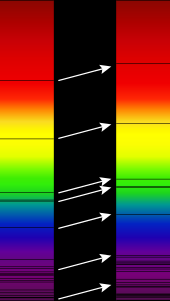https://en.wikipedia.org/wiki/Redshift...says
........As a result, photons propagating through the expanding space are stretched, creating the cosmological redshift.......
Now from a remote Galaxy, we hardly get few photons, the question is how do you stretch a single photon ??
Why do you need to ask such questions if you are god?

But as your pretentious and arrogant nature is now well known on this forum, let me try and help anyway.
With cosmological redshift the wave length is lengthened due to the expanding intervening space.
Lengthening the wavelength of any single photon needs to be considered in light of the duel nature of light.
Although it must be said that your inquiry, like your other inquiries, including the one's shifted to the fringes, do not appear genuine in nature and merely a means of pushing your well known agenda.
Here's a couple of proper links anyway.......
http://astronomy.swin.edu.au/cosmos/c/cosmological+redshift
Cosmological Redshift
Laboratory experiments here on Earth have determined that each
element in the periodic table emits
photons only at certain
wavelengths (determined by the excitation state of the
atoms). These photons are manifest as either emission or
absorption lines in the spectrum of an astronomical object, and by measuring the position of these
spectral lines, we can determine which elements are present in the object itself or along the line of sight.
However, when
astronomers perform this analysis, they note that for most astronomical objects, the observed spectral lines are all shifted to longer (redder) wavelengths. This is known as ‘
cosmological redshift’ (or more commonly just ‘redshift’) and is given by:
for relatively nearby objects, where
z is the cosmological redshift, λobs is the observed
wavelengthand λrest is the emitted/absorbed wavelength.
Caused solely by the expansion of the
Universe, the value of the cosmological redshift indicates the recession
velocity of the object, or its
distance. For small velocities (much less than the
speed of light), cosmological redshift is related to recession velocity (
v ) through:
where
c the speed of light. At larger distances (higher
redshifts), using the theory of general relativity gives a more accurate relation for recession velocities, which can be greater than the speed of light. Note this doesn’t break the ultimate speed limit of
c in Special Relativity as nothing is actually moving at that speed, rather the entire distance between the receding object and us is increasing. This is a complex formula requiring knowledge of the overall expansion history of the universe to calculate correctly but a simple recession velocity is given by multiplying the
comoving distance (
D) of the object by the Hubble parameter at that redshift (
H) as:
Doppler Shift: the wavelength of the radiation detected depends on the motion of the object at the instant the
photon was emitted.
Credit: NASA/JPL-Caltech
Although cosmological redshift at first appears to be a similar effect to the more familiar
Doppler shift, there is a distinction. In Doppler Shift, the wavelength of the emitted radiation depends on the motion of the object at the instant the photons are emitted. If the object is travelling towards us, the wavelength is shifted towards the blue end of the spectrum, if the object is travelling away from us, the wavelength is shifted towards the red end. In cosmological redshift, the wavelength at which the radiation is
originally emitted is lengthened as it travels through (expanding)
space. Cosmological redshift results from the expansion of space itself and
not from the motion of an individual body.
For example, in a distant
binary system it is theoretically possible to measure both a Doppler shift and a cosmological redshift. The Doppler shift would be determined by the motions of the individual
stars in the binary – whether they were approaching or receding at the time the photons were emitted. The cosmological redshift would be determined by how far away the system was when the photons were emitted. The larger the distance to the system, the longer the emitted photons have travelled through expanding space and the higher the measured cosmological redshift.
Cosmological Redshift: the wavelength of the emitted radiation is lengthened due to the expansion of the Universe. In this animation, the
galaxy on the left was formed a long time ago, while the galaxy on the right was formed more recently. Although each galaxy emits the same wavelength of the light, the light from the left hand galaxy has spent longer travelling through the expanding Universe, and has therefore experienced a greater ‘stretching’ (redshift). Astronomers are able to determine how far away distant objects are by measuring this wavelength expansion.





